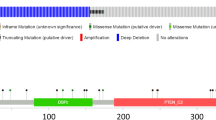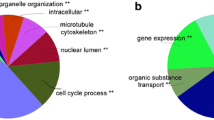Abstract
The global physiological function of specifically expressed genes of prostate cancer in Chinese patients is unclear. This study aims to determine the genome-wide expression of genes related to prostate cancer in the Chinese population. Genes that were differentially expressed in prostate cancer were identified using DNA microarray technology. Expressions were validated by using real-time PCR. The identified genes were analyzed using the ingenuity pathway analysis (IPA) to investigate the gene ontology, functional pathway and network. A total of 1,444 genes (Fold time ≥ 1.5; P ≤ 0.05) were differentially expressed in prostate primary tumor tissue compared with benign tissue. IPA revealed a unique landscape where inductions of certain pathways were involved in Cell Cycle Regulation and proliferation. Network analysis not only confirmed that protein interactions lead to the deregulation of DNA Replication, Recombination and Repair, Cellular Compromise and Cell Cycle, Genetic Disorders and Connective Tissue Disorders, but it was also observed that many of the genes regulated by Myc contributed to the modulation of lipid Metabolism and Nucleic Acid Metabolism. Both pathway and network analysis exhibited some remarkable characteristics of prostate cancer for Chinese patients, which showed profound differences from that of other non-Chinese populations. These differences may provide new insights into the molecular cascade of prostate cancer that occurs in Chinese patients.








Similar content being viewed by others


References
Jemal A, Siegel R, Xu J, Ward E. Cancer statistics, 2010. CA Cancer J Clin. 2010;60:277–300.
Mettlin C. Recent developments in the epidemiology of prostate cancer. Eur J Cancer. 1997;33:340–7.
Hughes C, Murphy A, Martin C, Sheils O, O’Leary J. Molecular pathology of prostate cancer. J Clin Pathol. 2005;58:673–84.
Quinn DI, Henshall SM, Sutherland LR. Molecular markers of prostate cancer outcome. Eur J Cancer. 2005;41:858–87.
Endo T, Uzawa K, Suzuki H, Tanzawa H, Ichikawa T. Characteristic gene expression profiles of benign prostatic hypertrophy and prostate cancer. Int J Oncol. 2009;35:499–509.
Savli H, Szendröi A, Romics I, Nagy B. Gene network and canonical pathway analysis in prostate cancer: a microarray study. Exp Mol Med. 2008;40:176–85.
Alavanja MC, Samanic C, Dosemeci M, Lubin J, Tarone R, Lynch CF, Knott C, Thomas K, Hoppin JA, Barker J, Coble J, Sandler DP, Blair A. Use of agricultural pesticides and prostate cancer risk in the Agricultural Health Study cohort. Am J Epidemiol. 2003;157(9):800–14.
Taylor BS, Schultz N, Hieronymus H, Gopalan A, Xiao Y, Carver BS, Arora VK, Kaushik P, Cerami E, Reva B, Antipin Y, Mitsiades N, Landers T, Dolgalev I, Major JE, Wilson M, Socci ND, Lash AE, Heguy A, Eastham JA, Scher HI, Reuter VE, Scardino PT, Sander C, Sawyers CL, Gerald WL. Integrative genomic profiling of human prostate cancer. Cancer Cell. 2010;18:11–22.
Florio T. Somatostatin/somatostatin receptor signalling: phosphotyrosine phosphatases. Mol Cell Endocrinol. 2008;286:40–8.
Fujinami K, Uemura H, Ishiguro H, Kubota Y. Liprin-alpha2 gene, protein tyrosine phosphatase LAR interacting protein related gene, is downregulated by androgens in the human prostate cancer cell line LNCaP. Int J Mol Med. 2002;10:173–6.
Blume-Jensen P, Hunter T. Oncogenic kinase signalling. Nature. 2001;411:355–65.
Ostman A, Hellberg C, Bohmer FD. Protein-tyrosine phosphatases and cancer. Nat Rev Cancer. 2006;6:307–20.
Scott A, Wang Z. Tumour suppressor function of protein tyrosine phosphatase receptor-T. Biosci Rep. 2011;31:303–7.
Wang Z, Shen D, Parsons DW, Bardelli A, Sager J, Szabo S, Ptak J, Silliman N, Peters BA, van der Heijden MS, Parmigiani G, Yan H, Wang TL, Riggins G, Powell SM, Willson JK, Markowitz S, Kinzler KW, Vogelstein B, Velculescu VE. Mutational analysis of the tyrosine phosphatome in colorectal cancers. Science. 2004;304:1164–6.
Wellcome Trust Case Control Consortium. Genome-wide association study of 14, 000 cases of seven common diseases and 3, 000 shared controls. Nature. 2007;447:661–78.
Murabito JM, Rosenberg CL, Finger D, Kreger BE, Levy D, Splansky GL, Antman K, Hwang SJ. A genome-wide association study of breast and prostate cancer in the NHLBI’s Framingham Heart Study. BMC Med Genet. 2007;8(Suppl 1):S6.
Birkenkamp-Demtroder K, Mansilla F, Sørensen FB, Kruhøffer M, Cabezón T, Christensen LL, Aaltonen LA, Verspaget HW, Ørntoft TF. Phosphoprotein Keratin 23 accumulates in MSS but not MSI colon cancers in vivo and impacts viability and proliferation in vitro. Mol Oncol. 2007;1:181–95.
Spijker S, Van Zanten JS, De Jong S, Penninx BW, van Dyck R, Zitman FG, Smit JH, Ylstra B, Smit AB, Hoogendijk WJ. Stimulated gene expression profiles as a blood marker of major depressive disorder. Biol Psychiatry. 2010;68(2):179–86. Epub 2010 May 14.
Agundez JA. Cytochrome P450 gene polymorphism and cancer. Curr Drug Metab. 2004;5:211–24.
Bartsch H, Nair U, Risch A, Rojas M, Wikman H, Alexandrov K. Genetic polymorphism of CYP genes, alone or in combination, as a risk modifier of tobacco-related cancers. Cancer Epidemiol Biomarkers Prev. 2000;9(1):3–28.
Fujimura T, Takahashi S, Urano T, Kumagai J, Murata T, Takayama K, Ogushi T, Horie-Inoue K, Ouchi Y, Kitamura T, Muramatsu M, Homma Y, Inoue S. Expression of cytochrome P450 3A4 and its clinical significance in human prostate cancer. Urology. 2009;74:391–7.
Siemes C, Visser LE, de Jong FH, Coebergh JW, Uitterlinden AG, Hofman A, Stricker BH, van Schaik RH. Cytochrome P450 3A gene variation, steroid hormone serum levels and prostate cancer–The Rotterdam Study. Steroids. 2010;75:1024–32.
Chung W, Kwabi-Addo B, Ittmann M, Jelinek J, Shen L, Yu Y, Issa JP. Identification of novel tumor markers in prostate, colon and breast cancer by unbiased methylation profiling. PLoS One. 2008;3:e2079.
Luxen S, Belinsky SA, Knaus UG. Silencing of DUOX NADPH oxidases by promoter hypermethylation in lung cancer. Cancer Res. 2008;68:1037–45.
McDonald ER III, El-Deiry WS. Cell cycle control as a basis for cancer drug development (Review). Int J Oncol. 2000;16:871–86.
Owa T, Yoshino H, Yoshimatsu K, Nagasu T. Cell cycle regulation in the G1 phase: a promising target for the development of new chemotherapeutic anticancer agents. Curr Med Chem. 2001;8:1487–503.
Mukhopadhyay UK, Senderowicz AM, Ferbeyre G. RNA silencing of checkpoint regulators sensitizes p53-defective prostate cancer cells to chemotherapy while sparing normal cells. Cancer Res. 2005;65:2872–81.
Kavitha CV, Choudhary B, Raghavan SC, Muniyappa K. Differential regulation of MRN (Mre11-Rad50-Nbs1) complex subunits and telomerase activity in cancer cells. Biochem Biophys Res Commun. 2010;399:575–80.
Mahajan NP, Liu Y, Majumder S, Warren MR, Parker CE, Mohler JL, Earp HS, Whang YE. Activated Cdc42-associated kinase Ack1 promotes prostate cancer progression via androgen receptor tyrosine phosphorylation. Proc Natl Acad Sci USA. 2007;104:8438–43.
Lindsey-Boltz LA, Sancar A. Tethering DNA damage checkpoint mediator proteins TopBP1 and Claspin to DNA activates ATR phosphorylation of Chk1. J Biol Chem. 2011;286:19229–36.
Gao T, Newton AC. The turn motif is a phosphorylation switch that regulates the binding of Hsp70 to protein kinase C. J Biol Chem. 2002;277:31585–92.
Kaufman L, Potla U, Coleman S, Dikiy S, Hata Y, Kurihara H, He JC, D’Agati VD, Klotman PE. Up-regulation of the homophilic adhesion molecule sidekick-1 in podocytes contributes to glomerulosclerosis. J Biol Chem. 2010;285:25677–85.
Chung S, Furihata M, Tamura K, Uemura M, Daigo Y, Nasu Y, Miki T, Shuin T, Fujioka T, Nakamura Y, Nakagawa H. Overexpressing PKIB in prostate cancer promotes its aggressiveness by linking between PKA and Akt pathways. Oncogene. 2009;28:2849–59.
Konishi N, Shimada K, Nakamura M, Ishida E, Ota I, Tanaka N, Fujimoto K. Function of JunB in transient amplifying cell senescence and progression of human prostate cancer. Clin Cancer Res. 2008;14:4408–16.
Tomkova K, Tomka M, Zajac V. Contribution of p53, p63, and p73 to the developmental diseases and cancer. Neoplasma. 2008;55:177–81.
Grisanzio C, Signoretti S. p63 in prostate biology and pathology. J Cell Biochem. 2008;103:1354–68.
Parsons JK, Gage WR, Nelson WG, De Marzo AM. p63 protein expression is rare in prostate adenocarcinoma: implications for cancer diagnosis and carcinogenesis. Urology. 2001;58:619–24.
Kiefer J, Alexander A, Farach-Carson MC. Type I collagen-mediated changes in gene expression and function of prostate cancer cells. Cancer Treat Res. 2004;118:101–24.
Gurel B, Iwata T, Koh CM, Jenkins RB, Lan F, Van Dang C, Hicks JL, Morgan J, Cornish TC, Sutcliffe S, Isaacs WB, Luo J, De Marzo AM. Nuclear MYC protein overexpression is an early alteration in human prostate carcinogenesis. Mod Pathol. 2008;21:1156–67. Epub 2008 Jun 20.
Sheehan GM, Kallakury BV, Sheehan CE, Fisher HA, Kaufman RP Jr, Ross JS. Loss of claudins-1 and -7 and expression of claudins-3 and -4 correlate with prognostic variables in prostatic adenocarcinomas. Hum Pathol. 2007;38:564–9.
Wang Q, Zheng JY, Kreth J, Yan X, Kamata M, Campbell RA, Xie Y, Chiu R, Berenson JR, Shi W, Chen IS, Pang S. Regulation of prostate-specific antigen expression by the junctional adhesion molecule A. Urology. 2009;73:1119–25.
Acknowledgments
This work was supported by grants from the Natural Science Foundation of Guangdong Province (04003650), National Natural Science Foundation of China (30872960), Key projects of Bureau of Health in Guangzhou Municipality (201102A212015) and projects of Guangdong Key Laboratory of Urology (2010A060801016).
Conflict of interest
All authors disclose any association that poses a conflict of interest in connection with the manuscript.
Author information
Authors and Affiliations
Corresponding authors
Additional information
Jia-hong Chen and Hui-chan He contributed equally to this work.
Microarray data are available on GEO (GSE28204).
Electronic supplementary material
Below is the link to the electronic supplementary material.
Rights and permissions
About this article
Cite this article
Chen, Jh., He, Hc., Jiang, Fn. et al. Analysis of the specific pathways and networks of prostate cancer for gene expression profiles in the Chinese population. Med Oncol 29, 1972–1984 (2012). https://doi.org/10.1007/s12032-011-0088-5
Received:
Accepted:
Published:
Issue Date:
DOI: https://doi.org/10.1007/s12032-011-0088-5


